Ancient Rome
Return to Drachmas, Dubloons, and Dollars homepage
The Romans established a highly centralized system of currency, which became the model for many later states. The first Roman currency consisted of heavy bronze bars, which were used to pay taxes or fines until as late as the 4th century BC. Contact with the Greek colonies of southern Italy and Sicily, as well as the pressures of the war against Hannibal of Carthage (218-202 BC), led to the adoption of a new silver denomination. This denarius remained the basis of Roman money for five centuries.
The rapid growth of the city of Rome into one of history’s most enduring empires went alongside a highly organized system of money. Under the Republic, which lasted until 31 BC, elected magistrates used coinage for expressing political messages. Coin production within the vast empire was enormous since the emperors used coins to create a positive public image by advertising everything from their various public works and military victories to domestic harmony. In a world in which most people were illiterate, images on coins were often the fastest way to get a particular message out to a large audience.
Frequent political and economic crises in the 3rd century AD caused massive inflation, which ultimately contributed to the fall of the Roman Empire. By the 5th century, much monetary wealth was concentrated in the treasuries of wealthy landowners and Christian churches.
Early Italian and Roman Republican Coinages (c. 500-88 BC)
Beginning in the 6th century BC, Italians used cast bronze ingots as money. In about 300 BC, Rome struck the first silver coin, inspired by those of the Greek colonies in southern Italy. Rome introduced a new coinage in 212 BC, during the war against Hannibal and the Carthaginians. Based on the silver denarius and the bronze as, this currency system existed for many centuries.
Cast bronze ramo secco (“dry branch”) bar (3rd century BC).
Cast bronze aes grave (3rd century BC), depicting the head of the god Apollo.
Silver didrachmon (270-260 BC), with a she-wolf and the twins Romulus and Remus, carrying the inscription “[money] of the Romans.”
Silver quadrigatus (c. 225 BC) depicting Jupiter in a chariot.
Bronze as (211-210 BC) depicting the prow of a ship.
Silver denarius (209-208 BC) with the head of Roma; the X for the Roman numeral 10 is a value mark.
Silver denarius (113-112 BC) showing Roman citizens voting.
Etruscan gold 50 as piece (211-210 BC) with stylized lion’s head.
Silver denarius (90-88 BC) struck by insurgent Italian allies of the Marsic Confederation. The Marsic bull gores the Roman she-wolf; this scene proclaimed allied discontent over Roman refusal to extend citizenship.
Julius Caesar and the Late Republic (88-27 BC)
In the civil wars of the late Republic, rival commanders, such as Pompey the Great and the dictator Julius Caesar, vied for domination. On the Ides of March, 44 BC, Caesar was murdered by Brutus. By 31 BC, Octavian, adopted son of Caesar, had defeated his rivals Marc Antony and Queen Cleopatra of Egypt, becoming master of the Roman world.
Silver denarius (42-40 BC) of Sextus Pompeius, portraying his father, Pompey the Great.
Silver denarius (48 BC) depicting a chieftain defeated by Caesar.
Silver denarius (44 BC) portraying Caesar.
Silver denarius (43-42 BC) of Brutus depicting daggers and the cap of liberty—symbolizing freedom after Caesar’s death.
Bronze as (c. 38 BC) portraying Octavian, bearded, in mourning for Caesar.
Silver tetradrachmon (c. 36 BC) of Cleopatra VII.
Silver “legionary” denarius (32-31 BC) of Marc Antony, struck to pay his army before battle in 31 BC.
Augustus and the Roman Principate
In 27 BC, the Senate gave Octavian extraordinary powers and the title Augustus. As the first Roman emperor, Augustus restored peace and created the form of government, know as the Principate, that would be the model for Roman rulers for almost 300 years.
Gold aureus (33-29 BC) of Octavian with bare head.
Gold aureus (11-9 BC) of Octavian with his new title of Augustus and a laurel wreath.
Bronze sestertius struck by Tiberius (AD 34-35), commemorating Augustus as a god after his death. The inscription reads “For the Deified Augustus—the Senate and the Roman People.”
Nero (AD 54-68) and Propaganda
The beautiful bronze sestertii of Nero seem to glorify his own accomplishments; however, the port of Ostia was the work of his predecessor Claudius, and victory over Parthia was won by his general Corbulo.
Bronze sestertius (AD 64-66) of Nero with his portrait.
Bronze sestertius (AD 64-66) of Nero, depicting a bird’s-eye view of the harbor at Ostia.
Bronze sestertius (AD 64-66) of Nero, depicting the Temple of Janus with closed doors in honor of peace with Parthia. The inscription proclaims, “When peace was established on land and sea, he [Nero] closed the gates of Janus’ temple.”
Biblical Coins
New Testament reference to Roman coins show how important they were in daily life. Nevertheless, only pure Tyrian silver was accepted for taxes to the Jewish Temple in Jerusalem. The denarius of Tiberius is believed to be the coin referred to by Jesus when he advised followers, “Render unto Caesar what is Caesar’s and unto God what is God’s.”
Silver denarius of Tiberius (AD 14-37).
Bronze lepton of Pontius Pilate showing the lituus, a staff used by Roman priests to interpret omens.
Silver shekel (106 BC) of Tyre, later coins of this type were probably the 30 pieces of silver paid for Jesus’ arrest.
Silver shekel (AD 67) of Jewish forces during the First Jewish Revolt (AD 66-70) against Rome, depicting a chalice—a ritual vessel in the Jerusalem Temple.
Bronze sestertius of Vespasian commemorating the Roman victory in the First Jewish Revolt. Mourning Jewish woman and a bound prisoner appear beneath a palm tree.
Roman Provincial Coins
In the provinces, Greek cities and Roman colonies struck their own bronze coins. These coins carry the imperial portrait on the obverse and a reverse image of local significance.
Bronze coin of Pergamum under Caracalla (AD 211-217) depicting three temples dedicated to the emperors.
Bronze coin of Neapolis under Philip I (AD 244-249) depicting a she-wolf suckling the twins Romulus and Remus before a shrine on Mount Gerizim in Samaria.
Bronze drachma (AD 139-140) of Alexandria under Antoninus Pius (AD 138-161), depicting the head of the god Sarapis on a giant foot, an image of uncertain significance.
The Severan Family (AD 193-235)
The emperor Septimius Severus (AD 193-211), a native of the province of Africa (modern Tunisia and Libya), advertised the unity of his own family as a guarantee of Roman peace. In reality, his two sons Caracalla and Geta were bitter rivals.
Bronze sestertius (AD 196) of Septimius Severus, with his portrait.
Gold aureus (AD 206) of Septimius Severus depicting the Circus Maximus.
Gold aureus (AD 201) of Septimius Severus depicting his wife, Julia Domna, and his two sons, Caracalla and Geta.
Bronze coin of Stratonicea (c. AD 188-199) with portraits of Geta (left) and Caracalla (right). The head of Geta was chiseled off in accordance with an edict of condemnation issued by Caracalla after he murdered Geta in 212 AD.
Economic and Political Decline
In 215, Caracalla introduced a new denomination, the antoninianus, tariffed at 2 denarii, but with a silver content of only 1 1/2 denarii. Civil war and barbarian invasion drove emperors from 238 to 270 to debase the antoninianus to a miserable bronze coin with a silver content of 2%.
Silver antoninianus (AD 215-217) of Caracalla.
Silver antoninianus (AD 238-239) of Gordian III (AD 238-244).
Gold aureus (AD 256-257) of Valerian (AD 253-260). The small size of such gold coins is due to the economic crisis of the 3rd century.
Silver drahm of Sasanian Persian king Shapur I (AD 241-272). Shapur represents a low point of Roman military fortunes. In AD 260 he captured the emperor Valerian, who was later stuffed as a trophy of Sasanian victory.
Bronze antoninianus of the Gallo-Roman emperor Tetricus I (AD 270-273).
The Late Roman Empire (AD 284-476)
In 294, Diocletian (AD 284-305) issued a new silver-clad nummus and, in 301, briefly imposed price ceilings. Although civil wars sparked debasement and inflation, later emperors repeatedly reformed the base-metal coinage and maintained the gold solidus introduced by Constantine (AD 306-337).
Bronze nummus (AD 296-297) of Diocletian. This denomination, originally covered by a wash of silver, replaced the debased antoninianus.
Gold medallion (c. AD 293) of the First Tetrarchy with portraits of the four emperors.
Bronze maiorina (AD 347-351) of Constantius II with a sliver wash, depicting the chilling message of “Restoration of Blessed Times” with a Roman soldier spearing a fallen barbarian horseman.
Return to Drachmas, Dubloons, and Dollars homepage
Other pages of the exhibit:
[posts_grid columns=”4″ rows=”6″ order_by=”date” order=”ASC” meta=”no” link=”yes” category=”DrachmasDubloonsDollars”]




